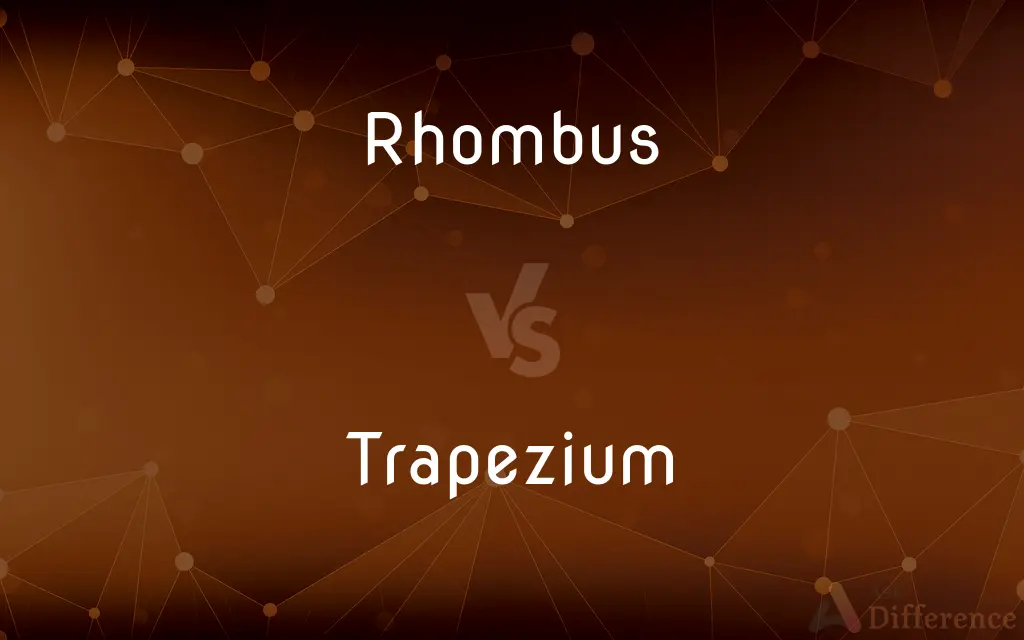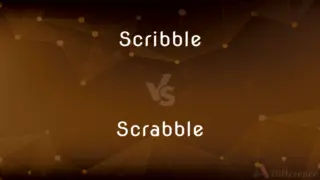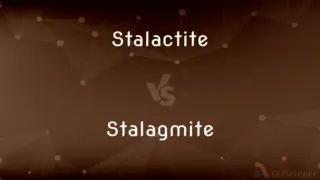Rhombus vs. Trapezium — What's the Difference?
Edited by Tayyaba Rehman — By Fiza Rafique — Updated on April 26, 2024
A rhombus is a quadrilateral with all sides of equal length, while a trapezium (US: trapezoid) has at least one pair of parallel sides.

Difference Between Rhombus and Trapezium
Table of Contents
ADVERTISEMENT
Key Differences
A rhombus is a type of parallelogram characterized by four sides of equal length and opposite sides that are parallel. On the other hand, a trapezium, known in the US as a trapezoid, is defined by having at least one pair of parallel sides, differing from the rhombus which has two pairs.
Both the rhombus and trapezium fall under the category of quadrilaterals, but their properties differ significantly in terms of symmetry and internal angles. A rhombus always has its opposite angles equal, whereas a trapezium does not necessarily follow this rule.
In terms of diagonal properties, a rhombus has diagonals that bisect each other at right angles and are also angle bisectors of the rhombus's angles. In contrast, the diagonals of a trapezium generally do not bisect each other at right angles nor are they angle bisectors.
The area calculation for a rhombus involves the product of its diagonals divided by two, reflecting the role of its symmetrical structure. For a trapezium, the area is calculated as half the product of the height and the sum of the two parallel sides, accommodating its asymmetrical shape.
While both shapes are used in various applications, the rhombus is often noted for its aesthetic and geometric properties, such as in tiling patterns. The trapezium, however, is frequently utilized in architectural designs and bridge constructions due to its unique shape.
ADVERTISEMENT
Comparison Chart
Sides
Four sides of equal length
At least one pair of parallel sides
Symmetry
Symmetrical about its diagonals
Not necessarily symmetrical
Diagonals
Bisect each other at right angles
Do not generally bisect at right angles
Angle Properties
Opposite angles are equal
Opposite angles are not equal
Area Calculation
Product of diagonals divided by two
Half the product of height and sum of parallel sides
Compare with Definitions
Rhombus
A parallelogram with equal-length sides.
A square is a special case of a rhombus with all right angles.
Trapezium
Used in architectural designs.
Trapezium shapes add visual interest and structural dynamics to buildings.
Rhombus
Quadrilateral with all sides equal.
A kite that forms a rhombus has two pairs of adjacent equal sides.
Trapezium
Varies widely in shape.
Trapeziums can range from narrow to wide, depending on the length ratio of the parallel sides.
Rhombus
Has diagonals that bisect each other at right angles.
The rhombus' diagonals create four right-angled triangles.
Trapezium
Can have right angles if it is a right trapezium.
A right trapezium has two right angles beside one of the parallel sides.
Rhombus
Often used in tiling.
Rhombus tiles fit together without gaps, creating a uniform pattern.
Trapezium
A quadrilateral having no parallel sides.
Rhombus
A diamond-shaped figure.
The rhombus shape is popular in jewelry designs.
Trapezium
Chiefly British A trapezoid.
Rhombus
In plane Euclidean geometry, a rhombus (plural rhombi or rhombuses) is a quadrilateral whose four sides all have the same length. Another name is equilateral quadrilateral, since equilateral means that all of its sides are equal in length.
Trapezium
(Anatomy)A bone in the wrist at the base of the thumb.
Rhombus
A quadrilateral all of whose sides have the same length.
Trapezium
A quadrilateral with two sides parallel.
Rhombus
An equilateral parallelogram, especially one having oblique angles. Also called rhomb.
Trapezium
(restrictively) A quadrilateral with two sides parallel and two sides non-parallel.
Rhombus
(geometry) A parallelogram having all sides of equal length.
Trapezium
A four-sided polygon with no parallel sides and no sides equal; a simple convex irregular quadrilateral.
Rhombus
The rhombus diamond, as one of the suits seen in a deck of playing cards (♦ or ♦).
Trapezium
(anatomy) The trapezium bone of the wrist.
Rhombus
In early Greek religion, an instrument whirled on the end of a string similar to a bullroarer.
Trapezium
A region on the ventral side of the brain, either just back of the pons Varolii, or, as in man, covered by the posterior extension of its transverse fibers.
Rhombus
Any of several flatfishes, including the brill and turbot, once considered part of the genus Rhombus, now in Scophthalmus.
Trapezium
A plane figure bounded by four right lines, of which no two are parallel.
Rhombus
Snails, now in genus Conus or family Conidae.
Trapezium
A bone of the carpus at the base of the first metacarpal, or thumb.
Rhombus
Same as Rhomb, 1.
Trapezium
A quadrilateral with no parallel sides
Rhombus
A parallelogram with four equal sides; an oblique-angled equilateral parallelogram
Trapezium
A multiple star in the constellation of Orion
Trapezium
The wrist bone on the thumb side of the hand that articulates with the 1st and 2nd metacarpals
Trapezium
A quadrilateral with at least one pair of parallel sides.
A trapezium can have non-parallel sides of different lengths.
Trapezium
Often used in bridge construction.
The trapezium shape helps distribute forces efficiently in bridge designs.
Common Curiosities
How does a trapezium differ from a trapezoid in terminology?
In British English, a trapezium has no parallel sides, while in American English, it refers to a quadrilateral with at least one pair of parallel sides, known elsewhere as a trapezoid.
How do the properties of rhombus and trapezium diagonals differ?
Rhombus diagonals bisect each other at right angles and are angle bisectors, whereas trapezium diagonals generally do not have these properties.
Can a rhombus be a square?
Yes, a square is a special type of rhombus where all angles are right angles.
Can a rhombus be used to illustrate mathematical concepts beyond geometry?
Yes, rhombuses are often used in physics to represent vectors and their resultant, as well as in complex number multiplication in algebra.
How does the area formula for a rhombus simplify real-world calculations?
The formula involving the product of the diagonals divided by two provides a quick and efficient way to calculate area when designing objects or structures that include rhombus shapes, such as windows, tiles, or art pieces.
What is the significance of a rhombus having its diagonals bisect each other at right angles?
This property allows a rhombus to have rotational symmetry and contributes to its applications in geometry and design, making it suitable for tessellations and optical illusions.
What are the typical applications of a trapezium?
Trapeziums are used in architectural structures and bridge construction due to their unique geometric properties.
What role does angle measurement play in distinguishing a rhombus from a trapezium?
A rhombus always has equal opposite angles, enhancing its symmetry. In contrast, the angles in a trapezium are not predetermined and can vary widely, affecting its overall symmetry and shape.
What defines a rhombus compared to other quadrilaterals?
A rhombus is defined by having all four sides of equal length and opposite sides that are parallel.
Why might an engineer choose a trapezium shape for bridge construction?
The trapezium shape allows for better distribution of loads and structural stability, especially in truss designs, accommodating varying spans and weight distributions.
Are all sides of a trapezium equal in length?
No, a trapezium does not necessarily have equal side lengths. Typically, only one pair of sides is parallel, and the other sides can vary in length.
Share Your Discovery

Previous Comparison
Scribble vs. Scrabble
Next Comparison
Stalactite vs. StalagmiteAuthor Spotlight
Written by
Fiza RafiqueFiza Rafique is a skilled content writer at AskDifference.com, where she meticulously refines and enhances written pieces. Drawing from her vast editorial expertise, Fiza ensures clarity, accuracy, and precision in every article. Passionate about language, she continually seeks to elevate the quality of content for readers worldwide.
Edited by
Tayyaba RehmanTayyaba Rehman is a distinguished writer, currently serving as a primary contributor to askdifference.com. As a researcher in semantics and etymology, Tayyaba's passion for the complexity of languages and their distinctions has found a perfect home on the platform. Tayyaba delves into the intricacies of language, distinguishing between commonly confused words and phrases, thereby providing clarity for readers worldwide.
















































